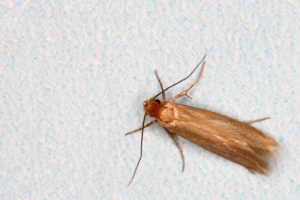Clothes Moth Prevention Tips
By Chris Williams on October 11, 2011.
I’ve had a problem in the past with clothes moths that I think I’ve finally solved. What can I do to keep from getting clothes moths again?
Good for you, being proactive. You already know that there’s something about your situation that clothes moths like so it’s important to change those “conducive conditions,” as we call them in the pest control business.
 The two most important things that you can do to prevent clothes moths are (1) proper cleaning of woolens and furs, and (2) proper storage of susceptible items. The items that you need to protect from clothes moths are wool clothing, angora or mohair items, wool carpets or rugs, rug pads made with wool or hair, upholstered furniture made of wool or stuffed with hair, furs and hides, feathers or down-stuffed items, animal bristles in brushes, animal trophy mounts, and wool felts in pianos. Synthetics or cotton fabrics can be fed on by clothes moths if they are blended with wool. Following the recommendations below should prevent future clothes moths infestations:
The two most important things that you can do to prevent clothes moths are (1) proper cleaning of woolens and furs, and (2) proper storage of susceptible items. The items that you need to protect from clothes moths are wool clothing, angora or mohair items, wool carpets or rugs, rug pads made with wool or hair, upholstered furniture made of wool or stuffed with hair, furs and hides, feathers or down-stuffed items, animal bristles in brushes, animal trophy mounts, and wool felts in pianos. Synthetics or cotton fabrics can be fed on by clothes moths if they are blended with wool. Following the recommendations below should prevent future clothes moths infestations:
- Vacuum frequently in areas where you have had clothes moths, and especially in often overlooked areas such as: under heavy pieces of furniture, inside dresser drawers, along baseboards and in cracks and crevices where pet hair and debris accumulate, in closets (especially those where woolens and furs are kept), and heating vents or air ducts. After an initial cleaning of these areas, dispose of any vacuum bag.
- Before storing woolens, furs, or hides, make sure they are clean. Items that are soiled with food, perspiration, or urine are much more readily attacked by clothes moths. Dry-cleaning will kill all stages of clothes moths that may already be present, and drycleaners can further mothproof items going into storage. Furniture and carpets can be steam-cleaned.
- Store items in airtight containers, not cardboard boxes. Cardboard boxes will not keep clothes moths out even with the use of moth balls. Use plastic tubs (like Tupperware storage bins) with locking lids or zip-lock plastic bags.
- If you use moth balls, flakes, or crystals containing naphthalene or paradichorobenzene, do so carefully. These items are toxic and must be kept away from children and pets. Don’t place them in direct contact with plastic buttons, hangers, or garment bags since the chemical may soften and melt some plastics. These repellents are only effective if used in sufficient amounts and if used in an airtight container. Cedar is not very effective against clothes moths.
- Woolen items that are stored for long periods, unused, are the most likely to become infested. Periodically remove these items from storage and brush them thoroughly, especially along seams and in folds and pockets. Brushing destroys eggs and exposes larvae. Then, give the items an airing in the sun before repacking them.
Stay up-to-date with Colonial Pest’s email newsletter!